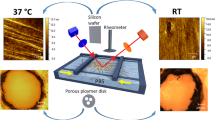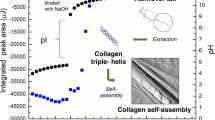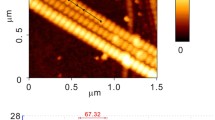Abstract
Type I collagen is widely used in various different forms for research and commercial applications. Different forms of collagen may be classified according to their source, extraction method, crosslinking and resultant ultrastructure. In this study, afibrillar and reconstituted fibrillar films, derived from acid soluble and pepsin digested Type I collagen, were analysed using Lateral Force Microscopy (LFM), Fourier Transform Infra-Red Spectroscopy (FTIR), Differential Scanning Calorimetry (DSC) and enzymatic stability assays to asses the influence of telopeptides, fibrils and crosslinking. LFM proved to be a useful technique to confirm an afibrillar/fibrillar ultrastructure and to elucidate fibril diameters. FTIR has proved insensitive to ultrastructural differences involving telopeptides and fibrils. DSC results showed a significant increase in Td for crosslinked samples (+22–28°C), and demonstrated that the thermal behaviour of hydrated, afibrillar films is more akin to reconstituted fibrillar films than monomeric solutions. The enzymatic stability assay has provided new evidence to show that afibrillar films of Type I collagen can be significantly more resistant to collagenase (by up to 3.5 times), than reconstituted fibrillar films, as a direct consequence of the different spatial arrangement of collagen molecules. A novel mechanism for this phenomenon is proposed and discussed. Additionally, the presence of telopeptide regions in afibrillar tropocollagen samples has been shown to increase resistance to collagenase by greater than 3.5 times compared to counterpart afibrillar atelocollagen samples. One-factor ANOVA analysis, with Fisher’s LSD post-hoc test, confirms these key findings to be of statistical significance (P < 0.05). The profound physicochemical effects of collagen ultrastructure demonstrated in this study reiterates the need for comprehensive materials disclosure and classification when using these biomaterials.






Similar content being viewed by others
References
Lee CH, Singla A, Lee Y. Biomedical applications of collagen. Int J Pharm. 2001;221:1–22.
Sachlos E, Gotora D, Czernuszka JT. Collagen scaffolds reinforced with biomimetic composite nano-sized carbonate-substituted hydroxyapatite crystals and shaped by rapid prototyping to contain internal microchannels. Tissue Eng. 2006;12:2479–87.
Sachlos E, Reis N, Ainsley C, Derby B, Czernuszka JT. Novel collagen scaffolds with predefined internal morphology made by solid freeform fabrication. Biomaterials. 2003;24:1487–97.
Wahl D, Sachlos E, Liu C, Czernuszka J. Controlling the processing of collagen-hydroxyapatite scaffolds for bone tissue engineering. J Mater Sci Mater Med. 2007;18:201–9.
Sachlos E, Czernuszka JT. Making tissue engineering scaffolds work. Review: the application of solid freeform fabrication technology to the production of tissue engineering scaffolds. Eur Cells Mater. 2003;5:29–40.
Carmichael DJ, Lawrie RA. Bovine collagen I changes in collagen solubility with animal age. Int J Food Sci Technol. 1967;2:299–311.
Chang MC, Ikoma T, Kikuchi M, Tanaka J. Preparation of a porous hydroxyapatite/collagen nanocomposite using glutaraldehyde as a crosslinkage agent. J Mater Sci Lett. 2001;20:1199–201.
Cappabianca P, Esposito F, Cavallo LM, et al. Use of equine collagen foil as dura mater substitute in endoscopic endonasal transsphenoidal surgery. Surg Neurol. 2006;65:144–8.
Spira M, Liu B, Xu Z, Harrell R, Chahadeh H. Human amnion collagen for soft tissue augmentation—biochemical characterizations and animal observations. J Biomed Mater Res. 1994;28:91–6.
Olsen D, Yang C, Bodo M, et al. Recombinant collagen and gelatin for drug delivery. Adv Drug Deliv Rev. 2003;55:1547–67.
George J, Onodera J, Miyata T. Biodegradable honeycomb collagen scaffold for dermal tissue engineering. J Biomed Mater Res A. 2008;87A:1103–11.
Riemschneider R, Abedin MZ. Pepsin-solubilized collagen from cow placenta. Angew Makromol Chem. 1979;82:171–86.
Gross J, Kirk D. The heat precipitation of collagen from neutral salt solutions: some rate-regulating factors. J Biol Chem. 1958;233:355–60.
Steven FS. The presence of non-protein nitrogen in acetic acid-soluble calf-skin collagen. Biochem J. 1962;83:240.
Einbinder J, Schubert M. Binding of mucopolysaccharides and dyes by collagen. J Biol Chem. 1951;188:335–41.
Steven FS. Purification and amino acid composition of monomeric and polymeric collagens. Biochem J. 1967;104:534.
Grant ME. Carbohydrate content of bovine collagen preparations. Biochem J. 1968;108:587.
Eyre DR, Paz MA, Gallop PM. Cross-linking in collagen and elastin. Annu Rev Biochem. 1984;53:717–48.
Woodley DT, Yamauchi M, Wynn KC, Mechanic G, Briggaman RA. Collagen telopeptides (cross-linking sites) play a role in collagen gel lattice contraction. J Invest Dermatol. 1991;97:580–5.
Kadler KE, Hojima Y, Prockop DJ. Assembly of collagen fibrils de novo by cleavage of the Type I pC-collagen with procollagen C-proteinase. Assay of critical concentration demonstrates that collagen self-assembly is a classical example of an entropy-driven process. J Biol Chem. 1987;262:15696–701.
Gale M, Pollanen MS, Markiewicz P, Goh MC. Sequential assembly of collagen revealed by atomic force microscopy. Biophys J. 1995;68:2124–8.
Helseth DL Jr, Veis A. Collagen self-assembly in vitro. Differentiating specific telopeptide-dependent interactions using selective enzyme modification and the addition of free amino telopeptide. J Biol Chem. 1981;256:7118–28.
Brennan M, Davison PF. Influence of the telopeptides on Type I collagen fibrillogenesis. Biopolymers. 1981;20:2195–202.
Comper WD, Veis A. The mechanism of nucleation for in vitro collagen fibril formation. Biopolymers. 1977;16:2113–31.
Leibovic SJ. Electron microscope studies of effects of endopeptidase and exopeptidase digestion on tropocollagen. Biochim Biophys Acta. 1970;214:445.
Zeugolis DI, Paul RG, Attenburrow G. Factors influencing the properties of reconstituted collagen fibers prior to self-assembly: animal species and collagen extraction method. J Biomed Mater Res A. 2008;86A:892–904.
Lynn AK, Yannas IV, Bonfield W. Antigenicity and immunogenicity of collagen. J Biomed Mater Res B Appl Biomater. 2004;71B:343–54.
Klein AW. Tissue augmentation in clinical practice. 1st ed. New York: Marcel Dekker; 1998.
Cao H, Xu S-Y. EDC/NHS-crosslinked Type II collagen-chondroitin sulfate scaffold: characterization and in vitro evaluation. J Mater Sci Mater Med. 2008;19:567–75.
McPherson JM, Sawamura S, Armstrong R. An examination of the biologic response to injectable, glutaraldehyde cross-linked collagen implants. J Biomed Mater Res. 1986;20:93–107.
Sionkowska A, Kaminska A. Thermal helix-coil transition in UV irradiated collagen from rat tail tendon. Int J Biol Macromol. 1999;24:337–40.
Rabotyagova OS, Cebe P, Kaplan DL. Collagen structural hierarchy and susceptibility to degradation by ultraviolet radiation. Mater Sci Eng C. 2008;28:1420–9.
Speer DDP, Chvapil MM, Eskelson CCD, Ulreich JJ. Biological effects of residual glutaraldehyde in glutaraldehyde-tanned collagen biomaterials. J Biomed Mater Res. 1980;14:753–64.
Weadock KS, Miller EJ, Keuffel EL, Dunn MG. Effect of physical crosslinking methods on collagen-fiber durability in proteolytic solutions. J Biomed Mater Res. 1996;32:221–6.
Weadock KS, Miller EJ, Bellincampi LD, Zawadsky JP, Dunn MG. Physical crosslinking of collagen fibers: Comparison of ultraviolet irradiation and dehydrothermal treatment. J Biomed Mater Res. 1995;29:1373–9.
Thompson JI, Czernuszka JT. The effect of two types of cross-linking on some mechanical properties of collagen. Bio-Med Mater Eng. 1995;5:37–48.
Angele P, Abke J, Kujat R, et al. Influence of different collagen species on physico-chemical properties of crosslinked collagen matrices. Biomaterials. 2004;25:2831–41.
Lee JM, Edwards HHL, Pereira CA, Samii SI. Crosslinking of tissue-derived biomaterials in 1-ethyl-3-(3-dimethylaminopropyl)-carbodiimide (EDC). J Mater Sci Mater Med. 1996;7:531–41.
Christiansen DL, Huang EK, Silver FH. Assembly of Type I collagen: fusion of fibril subunits and the influence of fibril diameter on mechanical properties. Matrix Biol. 2000;19:409–20.
Milch RA. Aqueous solution infrared spectra of collagen-reactive aldehydes. Biochim Biophys Acta. 1964;93:45–53.
Jakobsen RJ, Brown LL, Hutson TB, Fink DJ, Veis A. Intermolecular interactions in collagen self-assembly as revealed by Fourier transform infrared spectroscopy. Science. 1983;220:1288–90.
George A, Veis A. FTIRS in water demonstrates that collagen monomers undergo a conformational transition prior to thermal self-assembly in vitro. Biochemistry. 1991;30:2372–7.
Prystupa DA, Donald AM. Infrared study of gelatin conformations in the gel and sol states. Polym Gels Networks. 1996;4:87–110.
Paschalis EP, Verdelis K, Doty SB, Boskey AL, Mendelsohn R, Yamauchi M. Spectroscopic characterization of collagen cross-links in bone. J Bone Miner Res. 2001;16:1821–8.
Foltran I, Roveri EFBPPSN. Novel biologically inspired collagen nanofibers reconstituted by electrospinning method. Macromol Symp. 2008;269:111–8.
Friess W, Lee G. Basic thermoanalytical studies of insoluble collagen matrices. Biomaterials. 1996;17:2289–94.
Kopp JJ, Bonnet MM, Renou JJP. Effect of collagen crosslinking on collagen-water interactions (a DSC investigation). Matrix. 1989;9:443–50.
Flandin F, Buffevant C, Herbage D. A differential scanning calorimetry analysis of the age-related changes in the thermal stability of rat skin collagen. Biochim Biophys Acta. 1984;791:205–11.
Ala-aho R, Kähäri V-M. Collagenases in cancer. Biochimie. 2005;87:273–86.
Chung L, Dinakarpandian D, Yoshida N, et al. Collagenase unwinds triple-helical collagen prior to peptide bond hydrolysis. EMBO J. 2004;23:3020–30.
Tam EM, Moore TR, Butler GS, Overall CM. Characterization of the distinct collagen binding, helicase and cleavage mechanisms of matrix metalloproteinase 2 and 14 (gelatinase A and MT1-MMP): the differential roles of the MMP hemopexin C domains and the MMP-2 fibronectin Type II modules in collagen triple helicase activities. J Biol Chem. 2004;279:43336–44.
von Heimburg D, Zachariah S, Kühling H, et al. Human preadipocytes seeded on freeze-dried collagen scaffolds investigated in vitro and in vivo. Biomaterials. 2001;22:429–38.
Sakai T, Gross J. Some properties of the products of reaction of tadpole collagenase with collagen. Biochemistry. 1967;6:518–28.
Yannas IV, Burke JF, Huang C, Gordon PL. Correlation of in vivo collagen degradation rate with in vitro measurements. J Biomed Mater Res. 1975;9:623–8.
Hong S, Hong S, Wallace J, Kohn D. Ultrastructural observation of electron irradiation damage of lamellar bone. J Mater Sci Mater Med. 2009;20:959–65.
Chernoff EAG, Chernoff DA. Atomic force microscope images of collagen fibers. J Vac Sci Technol A. 1992;10:596–9.
Muyonga JH, Cole CGB, Duodu KG. Fourier transform infrared (FTIR) spectroscopic study of acid soluble collagen and gelatin from skins and bones of young and adult Nile perch (Lates niloticus). Food Chem. 2004;86:325–32.
Leikina E, Mertts MV, Kuznetsova N, Leikin S. Type I collagen is thermally unstable at body temperature. Proc Natl Acad Sci USA. 2002;99:1314–8.
Miles CA, Ghelashvili M. Polymer-in-a-box mechanism for the thermal stabilization of collagen molecules in fibers. Biophys J. 1999;76:3243–52.
Perumal S. Collagen fibril architecture, domain organization, and triple-helical conformation govern its proteolysis. Proc Nat Acad Sci USA. 2008;105:2824.
Netzel-Arnett S, Fields GB, Birkedal-Hansen H, Van Wart HE, Fields G. Sequence specificities of human fibroblast and neutrophil collagenases. J Biol Chem. 1991;266:6747–55.
Leibovich SJ, Weiss JB. Failure of human rheumatoid synovial collagenase to degrade either normal or rheumatoid arthritic polymeric collagen. Biochim Biophys Acta. 1971;251:109–18.
Author information
Authors and Affiliations
Corresponding author
Rights and permissions
About this article
Cite this article
Walton, R.S., Brand, D.D. & Czernuszka, J.T. Influence of telopeptides, fibrils and crosslinking on physicochemical properties of Type I collagen films. J Mater Sci: Mater Med 21, 451–461 (2010). https://doi.org/10.1007/s10856-009-3910-2
Received:
Accepted:
Published:
Issue Date:
DOI: https://doi.org/10.1007/s10856-009-3910-2




